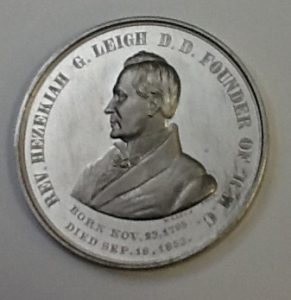
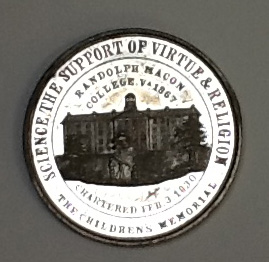
The Rev. Hezekiah G. Leigh medal shown here, with Reverend Hezekiah G. Leigh on one side and the main building of Randolph-Macon College in Boydton on the reverse side, was produced in 1867 by the College and distributed by the Richmond Christian Advocate, the Methodist newspaper in Virginia, as a means to raise funds for the repair of Randolph-Macon College after the Civil War. Contributors to the fund would receive a medal of Rev. Leigh, Bishop Joshua Soule, or both, depending on the amount of their gift. During this era, memorabilia with images of respected individuals was popular appearing as prints, statues and busts, plates, medals, and other items.
Advertisements for the medals appeared in several publications. The February, 1868 issue of the Southern Planter and Farmer magazine included this one:
“Beautiful Medallion Likenesses of Bishop Soule and Rev. Hezekiah
G. Leigh, D. D.
We are indebted to the courtesy of the President of Randolph Macon College for the above named Medals. These eminent men of God, whose names adorn the annals of the Methodist Episcopal Church, South, and whose distinguished faithful and efficient labors in the gospel have enshrined their blessed memories as “holy relics” in the hearts of all true Methodists, are most beautifully and artistically expressed in bas-relief likenesses of admirable truthfulness on metalic disks of bright untarnished lustre. These souvenirs are offered to those who contribute to the fund being raised for the repairs of Randolph Macon College, upon the following terms:
A contribution of $2 entitles the donor to the likeness of the Bishop.
A contribution of $1 to that of Dr. Leigh, the founder of the College.
And for three dollars both will be given to the contributor.
Address Rev. S. T. Moorman, care of the Richmond Christian Advocate.”
Unfortunately, funds were still tight in post-war Virginia and very little money was raised this way, so the repairs were never made to the College’s main building in Boydton. The College had closed in 1862 for the duration of the war and although there was no military activity in Mecklenburg County, the College’s main building was occupied for four months by the Union Army at the end of the war and sustained damage, although we have no documentation of the nature and extent of that damage. The College moved to Ashland in 1868 instead, selling the property in Boydton.
To see this item or other materials pertaining to the history of Randolph-Macon College, contact us at archives@rmc.edu.

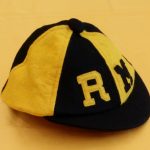
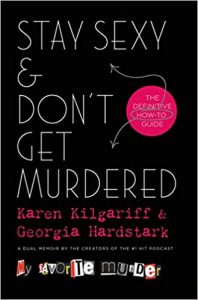
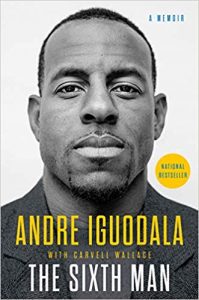 The standout memoir from NBA powerhouse Andre Iguodala, the indomitable sixth man of the champion Golden State Warriors. Andre Iguodala is one of the most admired players in the NBA. And fresh off the Warriors’ third NBA championship in the last four years, his game has never been stronger. Off the court, Iguodala has earned respect, too–for his successful tech investments, his philanthropy, and increasingly for his contributions to the conversation about race in America. It is no surprise, then, that in his first book, Andre–with his cowriter Carvell Wallace–has pushed himself to go further than he ever has before about his life, not only as an athlete but about what makes him who he is at his core. The Sixth Man traces Andre’s journey from childhood in his Illinois hometown to his Bay Area home court today. Basketball has always been there. But this is the story, too, of his experience of the conflict and racial tension always at hand in a professional league made up largely of African American men; of whether and why the athlete owes the total sacrifice of his body; of the relationship between competition and brotherhood among the players of one of history’s most glorious championship teams. And of what motivates an athlete to keep striving for more once they’ve already achieved the highest level of play they could have dreamed. On drive, on leadership, on pain, on accomplishment, on the shame of being given a role, and the glory of taking a role on: This is a powerful memoir of life and basketball that reveals new depths to the superstar athlete, and offers tremendous insight into most urgent stories being told in American society today.
The standout memoir from NBA powerhouse Andre Iguodala, the indomitable sixth man of the champion Golden State Warriors. Andre Iguodala is one of the most admired players in the NBA. And fresh off the Warriors’ third NBA championship in the last four years, his game has never been stronger. Off the court, Iguodala has earned respect, too–for his successful tech investments, his philanthropy, and increasingly for his contributions to the conversation about race in America. It is no surprise, then, that in his first book, Andre–with his cowriter Carvell Wallace–has pushed himself to go further than he ever has before about his life, not only as an athlete but about what makes him who he is at his core. The Sixth Man traces Andre’s journey from childhood in his Illinois hometown to his Bay Area home court today. Basketball has always been there. But this is the story, too, of his experience of the conflict and racial tension always at hand in a professional league made up largely of African American men; of whether and why the athlete owes the total sacrifice of his body; of the relationship between competition and brotherhood among the players of one of history’s most glorious championship teams. And of what motivates an athlete to keep striving for more once they’ve already achieved the highest level of play they could have dreamed. On drive, on leadership, on pain, on accomplishment, on the shame of being given a role, and the glory of taking a role on: This is a powerful memoir of life and basketball that reveals new depths to the superstar athlete, and offers tremendous insight into most urgent stories being told in American society today.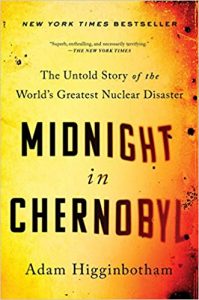 Early in the morning of April 26, 1986, Reactor Number Four of the Chernobyl Atomic Energy Station exploded, triggering history’s worst nuclear disaster. In the thirty years since then, Chernobyl has become lodged in the collective nightmares of the world: shorthand for the spectral horrors of radiation poisoning, for a dangerous technology slipping its leash, for ecological fragility, and for what can happen when a dishonest and careless state endangers its citizens and the entire world. But the real story of the accident, clouded from the beginning by secrecy, propaganda, and misinformation, has long remained in dispute. Drawing on hundreds of hours of interviews conducted over the course of more than ten years, as well as letters, unpublished memoirs, and documents from recently-declassified archives, Adam Higginbotham has written a harrowing and compelling narrative which brings the disaster to life through the eyes of the men and women who witnessed it firsthand. The result is a masterful nonfiction thriller, and the definitive account of an event that changed history: a story that is more complex, more human, and more terrifying than the Soviet myth. Midnight in Chernobyl is an indelible portrait of one of the great disasters of the twentieth century, of human resilience and ingenuity, and the lessons learned when mankind seeks to bend the natural world to his will—lessons which, in the face of climate change and other threats, remain not just vital but necessary.
Early in the morning of April 26, 1986, Reactor Number Four of the Chernobyl Atomic Energy Station exploded, triggering history’s worst nuclear disaster. In the thirty years since then, Chernobyl has become lodged in the collective nightmares of the world: shorthand for the spectral horrors of radiation poisoning, for a dangerous technology slipping its leash, for ecological fragility, and for what can happen when a dishonest and careless state endangers its citizens and the entire world. But the real story of the accident, clouded from the beginning by secrecy, propaganda, and misinformation, has long remained in dispute. Drawing on hundreds of hours of interviews conducted over the course of more than ten years, as well as letters, unpublished memoirs, and documents from recently-declassified archives, Adam Higginbotham has written a harrowing and compelling narrative which brings the disaster to life through the eyes of the men and women who witnessed it firsthand. The result is a masterful nonfiction thriller, and the definitive account of an event that changed history: a story that is more complex, more human, and more terrifying than the Soviet myth. Midnight in Chernobyl is an indelible portrait of one of the great disasters of the twentieth century, of human resilience and ingenuity, and the lessons learned when mankind seeks to bend the natural world to his will—lessons which, in the face of climate change and other threats, remain not just vital but necessary.